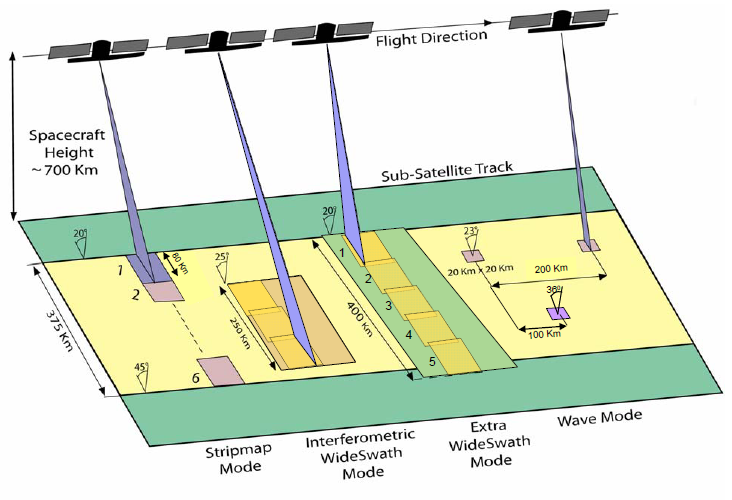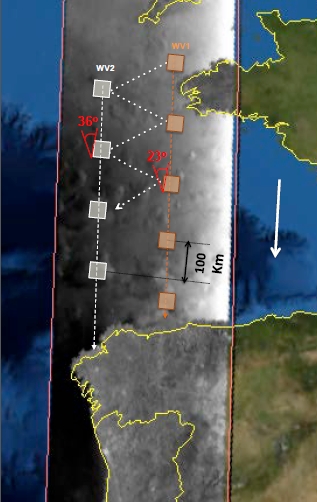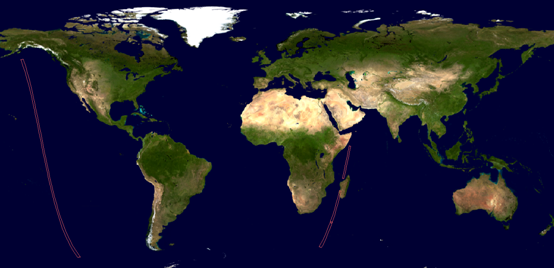Acquisition Modes - Sentinel-1 SAR Technical Guide - Sentinel Online
The SAR instrument operates in one of four exclusive modes:
- Stripmap (SM)
- Interferometric Wide Swath (IW)
- Extra Wide Swath (EW)
- Wave (WV).
The SM, IW and EW imaging modes can operate for a maximum duty cycle of 25 min per orbit. The WV mode operates for up to a maximum duty cycle of 75 min per orbit.
The SM, IW, and EW modes support operation in selectable single polarisation (HH or VV) and dual polarisation (HH+HV, VV+VH), implemented through one transmit chain (switchable to H or V) and two parallel receive chains for H and V polarisation. The WV mode only supports selectable single polarisation (HH or VV).
 |
Stripmap Mode
In stripmap mode, the instrument provides uninterrupted coverage with a geometric resolution of 5 m by 5 m at a swath width of 80 km. Six overlapping swaths cover a range of 375 km. For each swath, the antenna is configured to generate a beam with fixed azimuth and elevation pointing. Elevation beam forming is applied to suppress range ambiguity. Stripmap mode will only be operated on request for extraordinary situations.
Interferometric Wide Swath Mode
The Interferometric Wide swath (IW) mode implements a new type of ScanSAR mode called Terrain Observation with Progressive Scan (TOPS) SAR aimed at reducing the drawbacks of the ScanSAR mode. The basic principle of TOPSAR is the shrinking of the azimuth antenna pattern (along track direction) as seen by a spot target on the ground. This is obtained by steering the antenna in the opposite direction as for Spotlight support.
TOPSAR mode aims to achieve the same coverage and resolution as ScanSAR, but with a nearly uniform Signal-to-Noise Ratio (SNR) and Distributed Target Ambiguity Ratio (DTAR).
TOPS employs a rotation of the antenna in the azimuth direction. Similar to ScanSAR, several sub-swaths are acquired quasi-simultaneously by sub-swath switching from burst to burst. The increased swath coverage is achieved by a reduced azimuth resolution, as in ScanSAR. However, in TOPS the resolution reduction is obtained by shrinking virtually the effective antenna footprint to an on-ground target, rather than slicing the antenna pattern, as happens for ScanSAR.
The SENTINEL-1 C-SAR system is designed to enable TOPS burst synchronization of repeat-pass data-takes supporting the generation of TOPS interferograms and coherence maps. Specifically, for the IW and EW modes, the TOPS burst duration is 0.82 s and 0.54 s (worst case) respectively, with a requirement for achieving a synchronization of less than 5 ms between corresponding bursts. TOPSAR requires high accuracy for image co-registration. A small co-registration error in azimuth can introduce an azimuth phase ramp due to the SAR antenna azimuth beam sweeping causing Doppler centroid frequency variations of 5.5 kHz.
Extra Wide Swath Mode
Similar to IW mode, EW mode uses the TOPSAR technique to cover a very wide area of 400 km at medium resolution of 20 m by 40 m on the ground.
Wave Mode
In WV, a single stripmap image is acquired with an alternating elevation beam at a fixed on/off duty cycle, resulting in the generation of vignettes 20 by 20 km in size at regular intervals of 100 km.
Vignettes on the same incidence angle are separated by 200 km. Swaths alternate incidence angles between near range and far range (23° and 36.5° respectively).
 |
Wave mode is operated continuously over ocean, resulting in few long wave mode data-takes per orbit.
 |
Calibration Modes
The SENTINEL-1 SAR instrument also operates in RF Characterisation mode, Azimuth Notch mode and Elevation Notch mode. However, products from these modes are only used internally and not distributed by the PDGS.